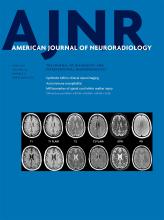Index by author
Pfaff, J.
- NeurointerventionYou have accessMinor Stroke Syndromes in Large-Vessel Occlusions: Mechanical Thrombectomy or Thrombolysis Only?M.P. Messer, S. Schönenberger, M.A. Möhlenbruch, J. Pfaff, C. Herweh, P.A. Ringleb and S. NagelAmerican Journal of Neuroradiology June 2017, 38 (6) 1177-1179; DOI: https://doi.org/10.3174/ajnr.A5164
Pierot, L.
- NeurointerventionYou have accessSafety and Efficacy of Aneurysm Treatment with the WEB: Results of the WEBCAST 2 StudyL. Pierot, I. Gubucz, J.H. Buhk, M. Holtmannspötter, D. Herbreteau, L. Stockx, L. Spelle, J. Berkefeld, A.-C. Januel, A. Molyneux, J.V. Byrne, J. Fiehler, I. Szikora and X. BarreauAmerican Journal of Neuroradiology June 2017, 38 (6) 1151-1155; DOI: https://doi.org/10.3174/ajnr.A5178
Pitteri, M.
- EDITOR'S CHOICEADULT BRAINOpen AccessHeterogeneity of Cortical Lesion Susceptibility Mapping in Multiple SclerosisM. Castellaro, R. Magliozzi, A. Palombit, M. Pitteri, E. Silvestri, V. Camera, S. Montemezzi, F.B. Pizzini, A. Bertoldo, R. Reynolds, S. Monaco and M. CalabreseAmerican Journal of Neuroradiology June 2017, 38 (6) 1087-1095; DOI: https://doi.org/10.3174/ajnr.A5150
The authors characterized the susceptibility mapping of cortical lesions in patients with MS (n=36) and compared it with neuropathologic observations (n=16). Neuropathologic analysis revealed the presence of an intense band of microglia activation close to the pial membrane in subpial cortical lesions or to the WM border of leukocortical cortical lesions. The quantitative susceptibility mapping analysis revealed 131 cortical lesions classified as hyperintense; 33, as isointense; and 84, as hypointense. They conclude that cortical lesion susceptibility maps are highly heterogeneous, even at individual levels and that the quantitative susceptibility mapping hyperintensity edge found in proximity to the pial surface might be due to the subpial gradient of microglial activation.
Pizzini, F.B.
- EDITOR'S CHOICEADULT BRAINOpen AccessHeterogeneity of Cortical Lesion Susceptibility Mapping in Multiple SclerosisM. Castellaro, R. Magliozzi, A. Palombit, M. Pitteri, E. Silvestri, V. Camera, S. Montemezzi, F.B. Pizzini, A. Bertoldo, R. Reynolds, S. Monaco and M. CalabreseAmerican Journal of Neuroradiology June 2017, 38 (6) 1087-1095; DOI: https://doi.org/10.3174/ajnr.A5150
The authors characterized the susceptibility mapping of cortical lesions in patients with MS (n=36) and compared it with neuropathologic observations (n=16). Neuropathologic analysis revealed the presence of an intense band of microglia activation close to the pial membrane in subpial cortical lesions or to the WM border of leukocortical cortical lesions. The quantitative susceptibility mapping analysis revealed 131 cortical lesions classified as hyperintense; 33, as isointense; and 84, as hypointense. They conclude that cortical lesion susceptibility maps are highly heterogeneous, even at individual levels and that the quantitative susceptibility mapping hyperintensity edge found in proximity to the pial surface might be due to the subpial gradient of microglial activation.
Prabhu, A.V.
- Spine Imaging and Spine Image-Guided InterventionsYou have accessEnhancing the Radiologist-Patient Relationship through Improved Communication: A Quantitative Readability Analysis in Spine RadiologyD.R. Hansberry, A.L. Donovan, A.V. Prabhu, N. Agarwal, M. Cox and A.E. FlandersAmerican Journal of Neuroradiology June 2017, 38 (6) 1252-1256; DOI: https://doi.org/10.3174/ajnr.A5151
Prabhu, V.
- ADULT BRAINYou have accessRole of High-Resolution Dynamic Contrast-Enhanced MRI with Golden-Angle Radial Sparse Parallel Reconstruction to Identify the Normal Pituitary Gland in Patients with MacroadenomasR. Sen, C. Sen, J. Pack, K.T. Block, J.G. Golfinos, V. Prabhu, F. Boada, O. Gonen, D. Kondziolka and G. FatterpekarAmerican Journal of Neuroradiology June 2017, 38 (6) 1117-1121; DOI: https://doi.org/10.3174/ajnr.A5244








